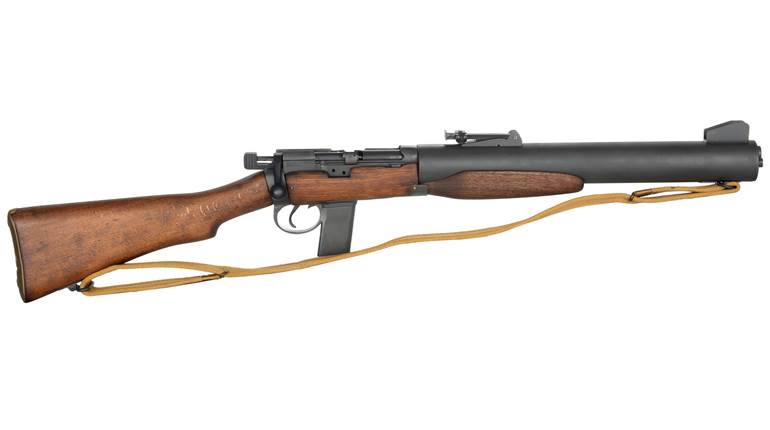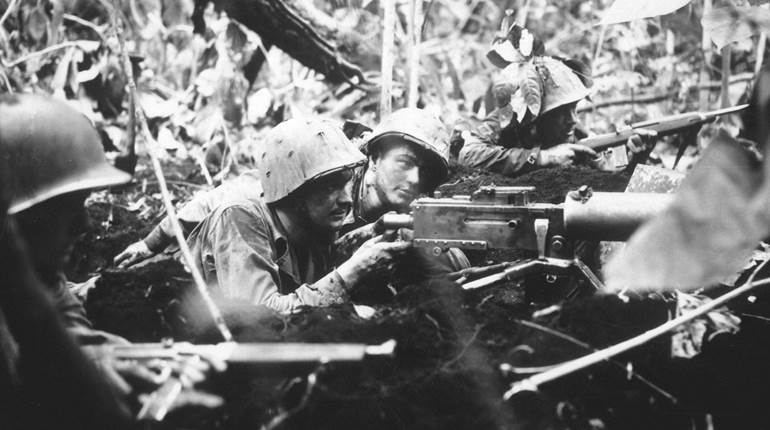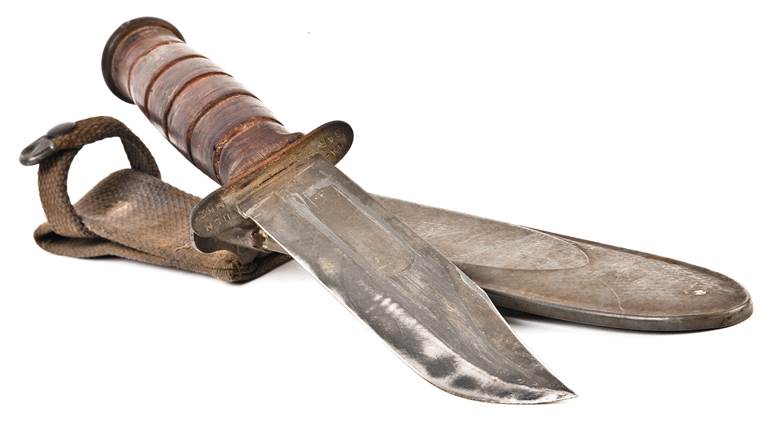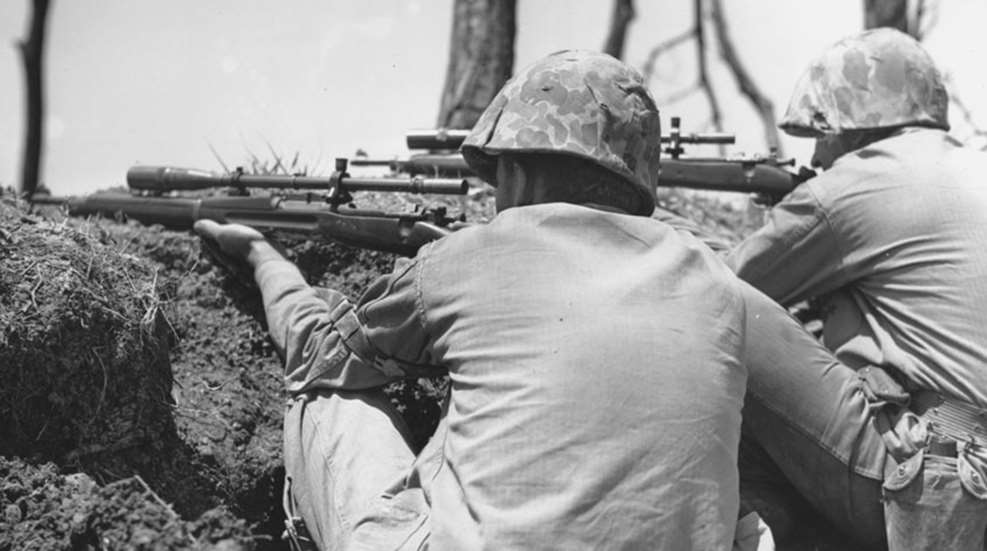
There are two Marine M1903 rifles fitted with Unertl riflescopes in this photo from Okinawa in May 1945. The rifle in the foreground is fitted with a Type S (straight grip) stock while the second, mostly obscured, sniper rifle appears to have a Type C (pistol grip) stock.
It was not until several years after the adoption of the U.S. Model of 1903 rifle that the first U.S. Army sniping rifle was standardized. In 1908, some M1903s were fitted with a rather unusual prismatic telescopic sight, the “Musket Sight, Model of 1908,” made by the Warner & Swasey Co. followed by a slightly improved version, the “Model of 1913.” Both were mounted on select ’03 rifles by Springfield Armory. During World War I, the standard U.S. Army sniper rifle was the M1903 fitted with a W&S M1913 scope. They saw a fair amount of combat use during the war, although reports of their actual effectiveness were mixed. By the mid-1920s, the M1903/W&S sniper rifles were withdrawn from use by the U.S. Army and National Guard, and most were sold as surplus. From the mid-1920s until World War II, the U.S. Army did not have any telescopic-sighted sniper rifles in inventory.

The U.S. Marine Corps took an entirely different course regarding sniping rifles. Several years after their adoption of the M1903 rifle, the Marines acquired some Winchester A5 commercial riflescopes. Unlike the Army’s unusual Warner & Swasey prismatic sight, the A5 was a conventional design with ocular and objective lenses, but windage and elevation adjustments were made via the rear mount. The Marines initially procured the Winchester A5 scopes not for sniping use, but for the telescopic-sighted rifles used by its shooting teams for competitions, such as the NRA National Matches.
The Winchester A5 riflescopes were fitted by Marine armorers to specially selected M1903 rifles. Several types of commercial mounts were used by the Marines with the A5 scopes during this period. When America entered World War I and the Marines deployed to France, they simply took along some of their rifle team M1903s with A5s for sniping use. After all, what better recommendation for a sniper rifle than the fact it was accurate enough for use in the exacting arena of competitive marksmanship competition? Circa 1917–1918, the Marines procured some specially made “Mann-Neider Modified Marine” tapered mounts for some of their M1903/A5 match rifles.
Unlike the Army, the Marines retained their telescopic-sighted rifles in inventory. At the time of Pearl Harbor, they still remained the Marines’ designated sniping arm. Winchester had ceased production of the A5 scope in the late 1920s, but Lyman began to manufacture essentially the same scope as the “5A.” While the Marines procured a number of Lyman 5As in the late 1920s and into the 1930s, many of the earlier Winchester A5s remained in use, if serviceable, as both were functionally identical.

In late-1940, the Marine Corps Equipment Board conducted tests, under the direction of Capt. George O. Van Orden, to determine what rifle/scope combination should be procured by the Corps to replace the aging—and not totally satisfactory—M1903/A5 (5A) rifles. After an extensive three-month evaluation, the board recommended to the commandant that the .30-’06 Sprg. Winchester Model 70 rifle with an 8X target scope from the J. Unertl Optical Co. would best suit the requirements for a new Marine Corps sniper rifle. But the director, division of plans and policies, did not approve the equipment board’s recommendations. It was assumed that any new sniper rifle would be based on the tried-and-proven ’03 Springfield. The Marines seemed to be satisfied with the same type of sniper rifle used in World War I, which was actually a target rifle pressed into duty as a sniper rifle.
After the attack on Pearl Harbor, there was renewed impetus for the development of a new sniper rifle, and requests were coming in from combat units deployed overseas. While a telescopic-sighted semi-automatic M1 was desired by the Ordnance Dept., the top-loading configuration of the Garand made mounting a scope directly over the receiver problematic. To get some sort of sniping rifle in the hands of the troops as soon as possible, the Ordnance Dept. adopted a slightly modified version of the M1903A3 rifle for the Army. The “U.S. Rifle, Caliber .30, M1903A4, (Sniper’s)” was fitted with a 2.5X telescope, the Weaver 330C (later designated by the military as the “M73B1”), a popular civilian sporting/hunting telescope. The Marines, on the other hand, were not enamored with the Army’s M1903A4, and sought a better solution. The only telescopic-sighted rifles in the Marine Corps’ inventory at the time were the ’03s with Lyman 5A or Winchester A5 telescopes, and a very limited number accompanied the Marines to their first significant offensive campaign in the Pacific, the invasion of Guadalcanal. While the M1903 was certainly a dependable and accurate rifle, the A5/5A telescopes were designed for target use and never intended to endure the rigors of combat. Clearly a better sniper rig was needed.
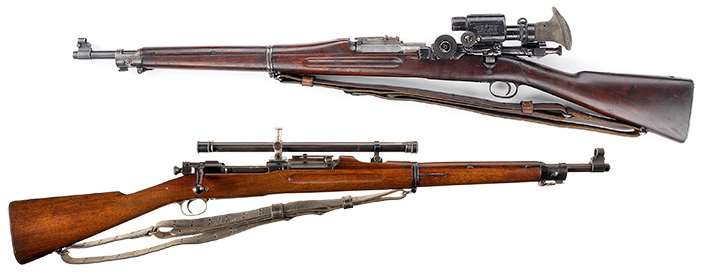
One of the first orders of business was to determine the best type of rifle and telescope. Such a rifle had to be chambered for the standard .30-’06 Sprg. cartridge, possess good accuracy and proven reliability, and have sufficient spare parts on hand. Such a rifle was already in service, the ’03 Springfield. While the standard-service Model 1903 rifle was capable of good accuracy, it made sense to acquire rifles with the highest degree of accuracy possible, which meant using either National Match rifles or service rifles that had been “tuned up” for increased accuracy in match competition and re-designated as “Special Target rifles.” A July 4, 1942, memo from the Depot Quartermaster, Philadelphia, Pa., revealed that the following rifles that fit these criteria were available:
“Subject: M1903 Rifles, national match and special target. There are on hand at this depot the following rifles, U.S. cal. .30, M1903: 104 – Rifles, U.S., cal. .30, M1903 national match, held for U.S. Marine Corps Reserve Rifle Team. 369 – Rifles U.S. cal. .30, M1903 national match, held for U.S. Marine Corps Rifle Team. 574 – Rifles, U.S. cal. 30, M1903 special target rifles, held for Division, Marine Corps and Elliot Trophy Team Matches. 1047 – Total.
“All the above rifles have bright bolts (polished and not Parkerized). It is recommended they be taken up as rifles, cal. .30, M1903 and issued as may be directed. If and when national matches are again held the U.S. Rifle, M1 undoubtedly will be the required rifle … .”
U.S. Marine Corps M1903A1 With 8X Unertl
Plans were made to mount the same type of Unertl scope recommended by Van Orden back in late-1940 on some of the M1903 National Match and Special Target rifles referenced above. The first Unertls were delivered to the Marines in late-1942, and it is believed the rifles were modified for use with these scopes at the USMC Philadelphia Depot.
The modifications to sniper configuration were simply to screw the front scope mount to the barrel and the rear scope mount to the receiver ring. It was necessary for the handguard to be modified by milling out a hole to accommodate the front sight base. Also, to aid in concealment, the bright bolts were blued.
Since the rifles were already set up for match use, no other modifications were generally required to make them superbly accurate sniper rifles. The Unertl scopes made under Marine Corps contract were marked on top of the tube “J. UNERTL” over “USMC - SNIPER” and then the scope’s serial number.
Although the scope was called an 8X (and is so marked), it was actually 7.8X. The similar Unertls made for civilian competitive shooting were equipped with a spring that brought the tube back into position after it moved rearward under recoil, but the USMC scopes did not have this feature. It was believed that sand or dirt could become lodged in the spring and score the tube. The lack of this return spring meant that the Marine snipers had to manually pull back the scope into battery after each shot. It is reported that some Marines improvised a makeshift mechanism to bring the scope back into position after each shot by the use of a slice of rubber taken from a truck inner tube, thus creating, in effect, a big rubber band that stretched between the front clamping ring and rear mount. In order to protect the scope when it was removed from the rifle, a cylindrical Micarta carrying case with cartridge belt hooks was provided.
Since the rifles used to create the Marine Corps’ latest sniper rifle were either Model 1903 National Match or Special Target rifles, most were fitted with Type C full-pistol-grip stocks. A May 24, 1943, memo from the commandant to the quartermaster read, “Type ‘C’ stocks should be provided if available.” Photographic evidence indicates that some of these rifles were fitted with straight-grip Type S stocks, presumably either due to a shortage of Type C stocks or to replace damaged stocks of that pattern.
Today the rifles are sometimes referred to as “Model 1941” or “Model 1942,” but the designations are incorrect. Most Marine Corps documents referred to them as “M1903A1 Rifle, Sniper, with Telescope Sight, Unertl 8X.”
By mid-1943, the M1903A1/Unertl sniper rifles began to see use in the Pacific Theater. A Sept. 23, 1943, Marine Corps memo referencing the distribution of these sniper rifles to the 4th Marine Division noted 87 would be provided to the unit. Noted researcher Frank Mallory stated that Marine Corps records reflect that “… the rifles were allocated on the basis of 9 per rifle company and 4 per headquarters in the Raider Battalion, it appears that they were never made an official part of the Table of Organization and Equipment (TO&E).” A Marine Corps memorandum dated Aug. 10, 1945, indicated that the “new allowance” for the M1903A1/Unertl sniper rifles would be changed to 108 per Marine division. Even after the new rifles came on the scene, a number of the older M1903 rifles with Lyman 5A scopes still remained in use.
There is some question as to the exact number of Unertl USMC sniper telescopes procured by the Marine Corps. As discussed by author and researcher Peter Senich: “With proper regards to the Unertl firm, and recognizing the difficulty in maintaining records for over 50 years, so far as it is known, a total of 3,500 scopes appear to have been actually ordered by the Marine Corps, the initial order being for 1,000 and the second for 2,500. However, according to USMC records, 1,750 Unertl telescopic sights had been accepted by the Marine Corps by April 1945, and, as then stated, this figure represented the ‘total delivered.’ Though additional deliveries may have taken place before the war ended a few weeks later, considering the overall situation, the status of the war at that point, and the controversy surrounding the suitability of the Unertl scope, further deliveries are believed to have been highly unlikely.”
Although as many as 1,750 Unertl scopes may have been procured by the Marines, this does not mean that a like number of M1903A1 rifles were fitted with the sights—there were only 1,047 M1903A1 National Match and Special Target rifles available for conversion into sniper rifles. Indeed, given the somewhat limited issuance of the sniper rifles to the various Marine divisions, it is clear that only a relatively small number of the rifles were actually converted to sniper configuration and issued. Some of the excess Unertl USMC Sniper scopes were sold as surplus after the war, and there are a number of standard M1903A1 rifles seen today that have been fitted with the scopes by civilian owners to create fake sniper rifles. If the work was properly done, it can be difficult to differentiate a genuine example from a well-done forgery—an example found today without convincing documentation should be worth no more than the sum value of its parts.

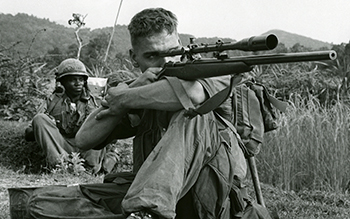 Ahead Of Its Time
Ahead Of Its Time
It is interesting to note that when the United States became actively involved in Vietnam, a favored Marine Corps sniper rifle was the Winchester Model 70 fitted with a Unertl 8X USMC telescope, exactly the same sniping rig recommended by Capt. Van Orden back in 1940!
M1903A1/Unertl Combat Use
While the Unertl telescope was great for Camp Perry, it was not designed for rough wartime use, and there were criticisms leveled regarding its robustness. That said, according to Senich, “By any measure, it was a superb sight, with the only genuine question being its durability for sustained use in a combat environment.” Despite any deficiencies, either real or imaged, noted riflescope authority and outdoorsman Bob Bell perhaps said it best; “It was, theoretically, too long, too fragile, too whatever. But infantrymen and Marines—and even Navy sharpshooters at times—went on aiming with it and squeezing them off, and enemy soldiers kept dropping. It’s hard to argue with results like that.”
A Marine scout-sniper combat veteran of the Pacific, who saw action on Tarawa, Saipan and Tinian with the 2nd Marine Division, succinctly stated the following regarding his M1903A1/Unertl sniper rifle: “We found it quite adequate. We found no faults with the scope.”
Despite these positive comments, the M1903A1s with Unertl scopes were not popular with many of the initial users. Documents indicate the 1st Marine Division at Cape Gloucester was unable to make effective use of its M1903A1/Unertl sniper rifles due to the climate and terrain. Also, the after action report of a Raider battalion that used the rifles on New Georgia Island between July and August 1943 stated that the rifles “… had no value.” It is possible, however, that this memo was actually referring to M1903s with the Lyman/Winchester scopes.
Regardless, this and other negative reports were given a lot of credence by the Marine Corps hierarchy, and the M1903A1/Unertl sniper rifle soon fell out of favor. Plans were made to adopt the Army’s M1903A4 sniper rifle instead. A Feb. 16, 1944, memo from the commandant to the quartermaster stated: “The Unertl, 8X, sniper telescope has not proved effective in combat. Accordingly, you are requested to cancel existing contracts for this item. Upon exhaustion of depot stocks of Unertl telescopes, please take steps to substitute the rifle U.S. cal. .30, M1903A4 (Sniper’s) equipped with Sight, Telescopic Assembly (Weaver 330C).”
Despite the desire to replace the M1903A1/Unertl rifles with the Army’s M1903A4s, the former sniper rifles remained in active use throughout the war. It seems a bit odd that the Marines’ rather abrupt reversal of policy regarding the Unertl sniper telescope changed after just a single after action report by the Raider battalion on New Georgia. The Chronological History Of The Sniper Rifle proffered the following rationale: “As so often happens, it appears that the experiences of one unit in one operation: this is, [the] Raider Battalion at New Georgia, have been sufficient to effectively damn a piece of equipment. The Unertl 8X scope evidently procured early in the war because it appeared, at that time, to answer the requirements. Because the Unertl scope was not satisfactory does not mean all scope-fitted rifles are useless for Marine Corps operations. The 1st Division at Cape Gloucester was unable to use scope-fitted rifles because of climate and terrain. The 2nd Division at Saipan used scope-fitted rifles very effectively.”
The success of the M1903A1/Unertl sniper rifle in the later campaigns, such as Saipan and Peleliu, occurring almost a year after the unsatisfactory experiences on New Georgia, mitigated the Marine Corps’ insistence on changing to the Army’s M1903A4 as soon possible. A Marine captain reported the following: “Success with the ’03A1/Unertl on Saipan and Peleliu during 1944 helped change official opinion. The more open terrain had favored employment of snipers with a long-range capability and the feedback to HQMC by early 1945 was considerably better than it had been. Another factor was the Army’s successful development of a telescope mounting system for the M1, the M1C, which gave snipers a semi-automatic capability. This eliminated the tell-tale movement required for operating the bolt on the ’03 to chamber a second round should another shot be necessary. The USMC was testing the M1C against the ’03A4 as the war ended. Meanwhile, snipers using the ’03A1/Unertls … were being employed with great success on Okinawa. These developments apparently led to the official reinstatement of snipers and their equipment in the Marine Corps organizations late in the war.”
The later success of the M1903A1/Unertl sniper rifle and the unavailability of M1903A4 or M1C rifles resulted in the former being the primary USMC sniper rifle through the end of World War II. An archival Marine Corps document reads: “In April, 1945, the QM General recommended that all M1903A1 sniper rifles, scopes, and associated equipment be disposed of as excess property. He stated that 1,750 scopes and 2,565 carrying cases had been delivered by Unertl, and that approximately 975 scopes remained on hand in depot stocks. There were also approximately 800 M1903A1 rifles in depot stocks that had been or were scheduled to be equipped with scope blocks. He further stated that 100 of these rifles were being delivered to the Navy for use in minesweeping operations. The chief of Plans and Policies Div. concurred in these recommendations.”
Some of these M1903A1/Unertl sniper rifles were employed by U.S. Navy sharpshooters onboard ships to explode floating mines. While the Marines did acquire some M1C rifles after World War II and used a number in the Korean War, a surprising number of M1903A1/Unertl sniper rifles also saw service in Korea in the 1950-1953 period.
While not used in large numbers as compared to other U.S. small arms of World War II—such as the M1 rifle, M1 carbine or BAR—the Marine M1903A1/Unertl sniper rifle is an impressive arm and was arguably the best American sniping rifle of the war.













